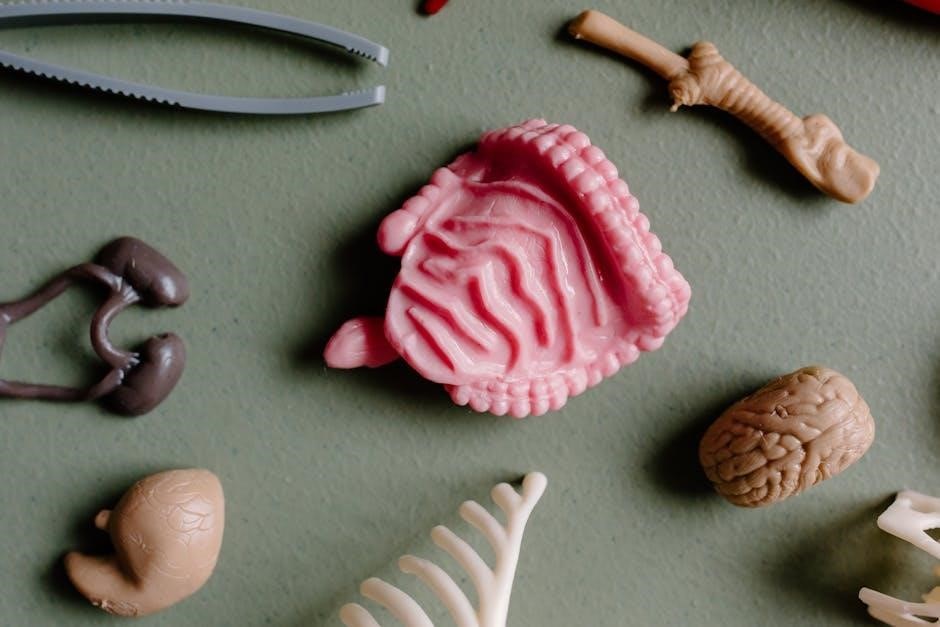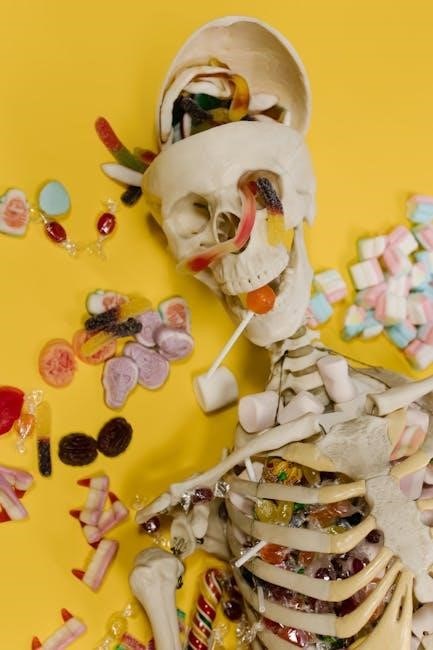Guided tissue regeneration and bone grafting are advanced dental surgical procedures aimed at reconstructing lost bone and tissue. These techniques promote bone growth, ensuring optimal conditions for dental implants and restoring oral functionality.
1.1 Definition and Purpose
Guided Tissue Regeneration (GTR) involves using barrier membranes to direct the growth of specific tissues, such as bone or periodontal ligaments, into defective areas. Bone grafting, on the other hand, introduces bone material—autogenous, allogenic, or synthetic—to promote new bone formation. Both procedures aim to restore lost dental structures, ensuring adequate support for implants, bridges, or dentures. They address bone deficiencies caused by trauma, disease, or extraction, ultimately improving oral function and aesthetics. These techniques are critical in modern dentistry for achieving long-term, stable results.
1.2 Historical Background
The concept of guided tissue regeneration (GTR) emerged in the 1950s, evolving from periodontal regeneration studies. Early techniques used physical barriers to contain grafts, with advancements in membrane materials in the 1980s. Bone grafting dates back to ancient civilizations, with modern techniques developing in the mid-20th century. The integration of biomaterials and growth factors has refined both procedures, enhancing predictability and outcomes; These historical milestones have established GTR and bone grafting as cornerstone therapies in contemporary dental surgery. Their evolution reflects ongoing research and clinical innovation.
Guided Tissue Regeneration (GTR)
Guided Tissue Regeneration (GTR) is a surgical procedure that uses barrier membranes to promote the growth of new periodontal structures, such as bone and ligaments.
2.1 Principles of GTR
Guided Tissue Regeneration (GTR) is based on the principle of using barrier membranes to direct the growth of specific tissues, such as bone and periodontal ligament, into defective areas. This technique excludes unwanted cells, like epithelial and connective tissue, from invading the defect, allowing preferred cells to regenerate the lost structures. The membranes are designed to degrade over time or remain permanent, depending on the material. GTR is widely used in treating periodontal defects and enhancing bone formation, often in combination with bone grafts for optimal results. This method is minimally invasive and promotes natural healing.
2.2 Membrane Types and Materials
In GTR, membranes are categorized into non-resorbable and resorbable types. Non-resorbable membranes, such as titanium-reinforced PTFE, require a second surgery for removal. Resorbable membranes, made from materials like collagen or synthetic polymers (e.g., PLA, PLGA), degrade naturally. Membrane choice depends on the defect’s size, healing goals, and patient-specific factors. Each material has unique properties, with non-resorbable offering durability and resorbable promoting tissue integration. These materials guide tissue growth effectively, ensuring targeted regeneration of bone and periodontal structures without interference from other cells.
2.3 Clinical Applications
Guided tissue regeneration is widely used to treat periodontal bone defects, enhance bone growth around dental implants, and repair sites with insufficient bone structure. It is particularly effective in regenerating lost periodontal ligaments and bone tissue. GTR is also applied in socket bone grafting after tooth extraction to preserve the alveolar ridge for future implants. Additionally, it is utilized in ridge augmentation procedures to restore the jawbone’s natural contour. These applications ensure optimal conditions for dental restorations, improving both functionality and aesthetics.
2.4 Advantages of GTR
Guided tissue regeneration offers several advantages, including minimal invasiveness and reduced patient discomfort compared to traditional bone grafting. It eliminates the need for harvesting bone from other body sites, lowering donor site morbidity. GTR promotes predictable bone growth, ensuring a stable foundation for dental implants. Additionally, it shortens recovery time and maintains soft tissue architecture, enhancing aesthetic outcomes. These benefits make GTR a preferred choice for treating periodontal defects and preparing implant sites efficiently. Its effectiveness in preserving tissue health further contributes to long-term oral functionality.
2.5 Disadvantages and Limitations
Guided tissue regeneration has several drawbacks, including high costs associated with specialized membranes and materials. The procedure requires precise surgical skill, limiting accessibility for some patients. Membrane exposure during healing can lead to complications, such as infection or graft failure. Additionally, GTR often involves extended healing times, delaying implant placement. It may also have limited success in cases of large bone defects or insufficient soft tissue support. These challenges highlight the need for careful patient selection and expertise in executing GTR procedures effectively.
Bone Grafting
Bone grafting is a surgical procedure that involves transplanting bone tissue to repair or rebuild defective jawbone areas, often necessary for dental implant placement or trauma repair.
3.1 Types of Bone Grafts
Bone grafts are categorized into autogenous, allogenic, xenogenic, and alloplastic types. Autogenous grafts, taken from the patient’s own body, offer high success rates due to optimal compatibility. Allogenic grafts use donor bone, processed for safety, and are readily available. Xenogenic grafts derive from non-human sources, while alloplastic grafts are synthetic, offering a cadaver-free option. Each type varies in healing potential and application, with autogenous being the gold standard for bone regeneration due to its osteogenic properties, though donor site morbidity remains a concern.
3.2 Autogenous vs. Allogenic Grafts
Autogenous grafts, taken from the patient’s body, offer superior compatibility and osteogenic properties, promoting faster healing. However, they require a donor site, leading to additional surgery and potential morbidity, which can be a significant drawback for patients. Allogenic grafts, sourced from donors and processed for safety, avoid the need for a second surgical site. While they reduce donor site complications, they may have lower success rates compared to autogenous grafts due to reduced biological activity. This trade-off is crucial in treatment planning.
3.3 Healing Process and Timeline
The healing process for bone grafts typically involves several stages, with initial osseointegration occurring within 2-4 months. Guided bone regeneration often requires 4-6 months for sufficient bone growth to support dental implants. Factors such as graft type, patient health, and surgical technique influence healing speed. Autogenous grafts generally heal faster due to their biological compatibility, while allogenic grafts may take longer. Growth factors and biomaterials can enhance recovery, ensuring optimal bone formation and stability for successful implant placement. Post-operative care is critical to avoid complications and promote proper tissue regeneration.
3.4 Advantages of Bone Grafting
Bone grafting offers several advantages, including the restoration of lost bone structure, which is essential for dental implant placement and overall oral functionality. It provides long-term stability and support for implants, bridges, and dentures. Additionally, bone grafting prevents further bone loss, halting the progression of degenerative changes. Autogenous grafts, using the patient’s own bone, have high success rates due to their biological compatibility. This procedure also enhances aesthetic outcomes by restoring natural facial contours, improving patient confidence and quality of life.
3.5 Disadvantages and Risks
Bone grafting, while effective, has notable drawbacks. Donor site morbidity is a significant risk, particularly with autogenous grafts, leading to pain and complications at the harvest site. Allogenic grafts carry a small risk of disease transmission. The procedure is often costly and time-consuming, requiring extended healing periods before implants can be placed. Additionally, graft failure due to infection or insufficient integration is a potential risk. These factors make bone grafting less accessible for some patients, highlighting the need for careful patient selection and consultation.

Guided Tissue Regeneration vs. Bone Grafting
Guided tissue regeneration and bone grafting are complementary techniques for addressing bone loss. GTR uses barriers to regenerate tissue, while bone grafting adds material to rebuild structure.
4.1 Key Differences
The primary distinction lies in their approach: GTR uses barrier membranes to guide tissue growth, whereas bone grafting involves adding bone material to deficient areas. GTR is less invasive, avoiding the need for harvesting bone from the patient or donor sources. Bone grafting, however, provides immediate structural support and is often necessary for larger defects. GTR is typically used for periodontal defects, while bone grafting is common in implantology to ensure adequate bone volume for dental implants. Each method offers unique advantages based on the clinical scenario.
4.2 Indications for Each Procedure
Guided tissue regeneration is ideal for treating periodontal defects, such as intrabony lesions, where the goal is to regenerate lost periodontal structures. It is non-invasive and does not require bone harvesting. Bone grafting, on the other hand, is typically indicated for larger bone defects, particularly in implantology, where insufficient bone volume exists for placing dental implants. It is also used to repair defects caused by trauma, gum disease, or congenital issues. Each procedure is chosen based on the extent and nature of the bone loss being addressed.
4.3 Clinical Efficacy Comparison
Guided tissue regeneration (GTR) demonstrates high success rates in treating periodontal defects, promoting predictable bone regeneration without donor site morbidity. Bone grafting is considered the gold standard for larger defects, offering reliable long-term results. However, bone grafting requires longer healing times and carries risks associated with donor sites. GTR is favored for its minimally invasive approach and faster recovery, while bone grafting is often preferred for complex, large-scale reconstructions. Both procedures show strong clinical outcomes, with selection based on defect size, patient health, and surgical goals.
Healing and Recovery
Healing and recovery involve tissue regeneration and bone integration. Both procedures require patience, with GTR typically showing faster recovery times and bone grafting needing extended healing periods.
5.1 Post-Operative Care
Post-operative care is crucial for successful healing in both guided tissue regeneration (GTR) and bone grafting. Patients should avoid disturbing the surgical site, maintaining a soft diet for several weeks. Proper oral hygiene is essential, with gentle brushing and rinsing to prevent infection. For GTR, protecting the membrane from dislodgement is key, while bone grafting requires monitoring for swelling or complications. Follow-up appointments ensure proper recovery, with healing times varying depending on the procedure and individual patient factors.
5.2 Recovery Time Comparison
Recovery times differ between guided tissue regeneration (GTR) and bone grafting. GTR typically requires 4-6 months for the bone to heal after membrane removal, delaying implant placement. Bone grafting, especially autogenous grafts, may integrate faster, often within 3-4 months, but larger grafts or those from donor sites can take 6-9 months. GTR involves a protective membrane, extending the healing period, while bone grafting allows earlier implant placement but may involve more extensive surgery and donor site recovery.

Cost and Accessibility
Bone grafting and guided tissue regeneration vary in cost due to materials and complexity. Bone grafting is often more expensive, especially with autogenous grafts, while GTR may involve membrane costs.
6.1 Financial Considerations
The cost of guided tissue regeneration (GTR) and bone grafting varies based on procedure complexity and materials. GTR typically involves membrane costs, which can range from $500 to $2,000. Bone grafting, especially autogenous grafts, is generally more expensive due to the surgical process of harvesting bone, with costs ranging from $2,000 to $5,000 or more. Additionally, factors like the surgeon’s expertise, location, and follow-up care contribute to overall expenses. Insurance coverage may partially offset these costs, but it often varies by case.
6.2 Availability of Procedures
Guided tissue regeneration (GTR) and bone grafting are widely available in dental surgeries, though their accessibility may vary by location and surgeon expertise. GTR is often a standard procedure in many dental clinics, while bone grafting, particularly autogenous grafts, may require specialized centers due to the need for donor site harvesting. Geographical disparities and the availability of skilled professionals can influence procedure accessibility. Additionally, the use of advanced biomaterials in bone grafting has expanded its reach, making it more accessible globally.

Future Trends and Innovations

Future trends in guided tissue regeneration and bone grafting focus on advanced biomaterials, growth factors, and 3D printing for enhanced bone and tissue healing outcomes.
7.1 Biomaterials in Regeneration
Advancements in biomaterials are revolutionizing guided tissue regeneration and bone grafting. Materials like collagen, hydroxyapatite, and synthetic polymers are being used to create bioactive scaffolds that guide cell growth and promote tissue integration. These materials are designed to mimic the natural extracellular matrix, enhancing bone and tissue regeneration. Researchers are also exploring bioactive materials that release growth factors to stimulate healing; Such innovations aim to reduce reliance on autografts and allografts, offering more predictable and efficient outcomes for patients undergoing dental and orthopedic procedures.
7.2 Growth Factors and Their Role
Growth factors, such as recombinant human platelet-derived growth factor-BB (rhPDGF-BB), play a pivotal role in tissue regeneration by stimulating cellular proliferation and differentiation. These bioactive molecules enhance bone and tissue repair by recruiting stem cells and promoting angiogenesis. In guided tissue regeneration and bone grafting, growth factors are integrated into biomaterials to accelerate healing and improve graft integration. Their targeted application reduces healing time and enhances the predictability of regeneration, offering promising clinical outcomes for patients with bone defects or tissue loss.
